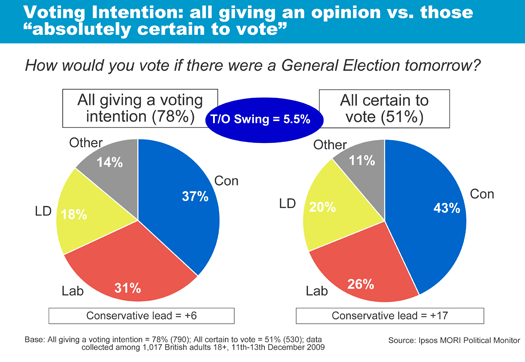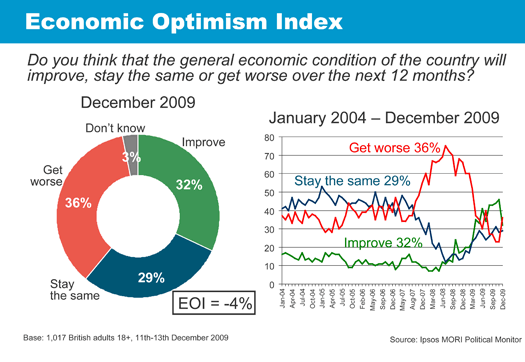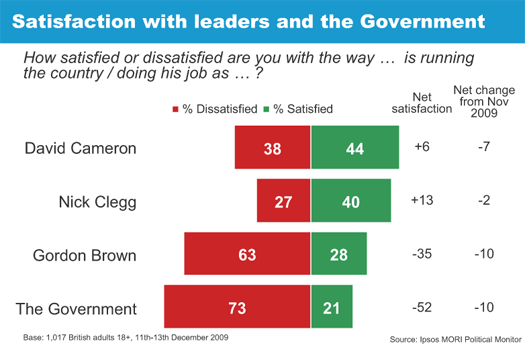Worcester's Weblog: PBR Sinks Labour
"What's going on, the polls seem all over the place?160 One says a lead of 6 and another a lead of 17. " I've been hearing that for many a year. So what is going on?160 Part of the answer is `events, dear boy, events" And the Pre-Budget Report (PBR) was not just an event on Wednesday the 9th of December, it was a big event.
160
Another part of the answer is the media's fixation on headlining the lead, both in print and in the broadcast media, rather than the shares, especially the share for the opposition.160 Nine out of the ten reported so far this month have had the Conservatives at or over the magic 40% level, where they've been hovering since the beginning of July.
160
Yet three polls had leads were of 17% including this month's Ipsos Political Monitor, and three, ICM (9%) and YouGov (9%) and Populus (8%), below 10%.160 Yet none, not one of the ten, have varied in their share of Tory vote by more than three percent, polls' statistical `margin of error'.
160
Third, they all `weight' their `raw' data in various ways, the way economists have different models on which they base their estimates.160 The best way to see the impact of this is to compare the `raw' data, and then you'd know the basis that they use to adjust their figures to balance the inherent anomalies (explained in full in the Quality section of our website). All the pollsters (except BPIX) have similar website detailed explanations, although some others are not fully transparent in their methodology, not willing to reveal their `raw' findings.
160
A fourth part is that what the media really want is the polls to be able to forecast the outcome of an election six months or more, yet none of us have crystal balls, read tea leaves or palms, at least not to my knowledge.160
160
If we sent our interviewers out to a carefully selected sample of constituencies across the country and got each one to stand in the highest point in the constituency and precisely noon read the carefully calibrated thermometers we armed them with, and struck the average temperature of the country in that way, and then to do the same the next day, no one would expect exactly the same average temperature.160 Yet public opinion is more variable than the weather tomorrow, much less than six months away.
160
From a six point Tory lead before the Pre-Budget Review to this month's 17, a swing of 5.5% in one week, which could see the Tories in with a landslide.
160
Currently the Conservatives are on 43%, 26% say they would be voting for Labour if the election were held tomorrow, and 20% say they'd vote Liberal Democrats.160 That's five or six people in a hundred changing their mind about who they think they'll vote for before and after the PBR.160160 UKIP gets four% and BNP two%, the Greens 3%, and others 2%.
160

160
The impact of the PBR moved the economic optimism in the country from last month's 46% believing the economy was going to improve in the next 12 months falling precipitously to 32%. At the same time, the satisfaction level of Gordon Brown fell another 10 points, to just 28% and the government also by 10 points, to 21%.
160
The impact of the PBR is felt by everyone.160 Most people, 69%, say that which party wins the election is important to them personally. If they weren't paying attention before, they are now.160
160
Overall, the percentage of people who expect the economy to improve has fallen from a remarkable 46% expecting the economy to improve in the next year, to 32%.160 What is interesting politically is who has fallen the furthest.160 Last month 41% of the youngest third of the electorate, those between 18 and 34, said they expected an upturn; this month it's still 41%.
160

160
But of those 55 and over, there's been a 20 point drop, from 50% optimistic, to 30%.160 This is a vitally important finding to all the parties, for those 55 and older have four times the voting power of the young. There are twice as many of them and they are twice as likely to vote.160 Other big drops came among men (-18) rather than women (-11), among the working class and those in the Midlands, and especially with those on a mortgage, who fell nearly by half, from 50% optimists to 27%.
160
The turnout is the key to the outcome of the next election.160 No election saw turnout under 70% from 1945 to 1997.160 Yet in 2001, only 59% of electors in Great Britain voted; in 2005 61%.160 In 1959 and again in February 1974 watershed elections, the turnout was over 78%.160 To get to that level, the reluctant Labour supporters who've sat on their hands in the last two elections would have to turn out by the thousands, especially in the marginal seats.160
160
Even to get a turnout of 60% would require a massive increase in a now relatively apathetic base of Labour abstainers.160 For while a turnout of just 50% would return a Tory majority over all other parties of over 100, a 78% turnout would see a Labour majority of about 25. At about 60%, a 40% Tory, 30% Labour, 20% LibDems, 10% others, would give the Conservatives a majority of around 20 seats over all other parties.160
160

160
Is fear of the Cameron/Osborne team enough to energise the Labour reluctants?
160
Whatever, last month's poll findings certainly put the frighteners into the Tories, hope into Labour's minds, and heart into the fond hope of the Liberal Democrats that there was a window of opportunity to hold the balance of power in a hung parliament.160 Last month the margin was closing, Post PBR it looks like it's Cameron for No. 10 without a massive and effective effort from the Labour campaign team.160 But a week, never mind a month, is a long time in politics.
160
Sir Robert Worcester is the Founder of MORI.160His latest book is "Explaining Labour's Landslip". This article was published in The Observer.



